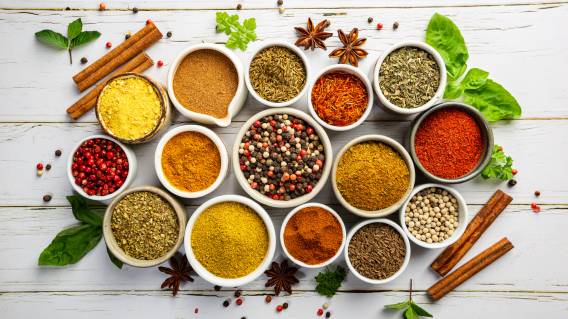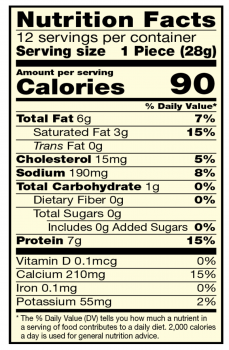
Aug. 29 is More Herbs, Less Salt Day. This awareness day was created because a significant number of Americans consume too much salt. Excess salt is linked to many health problems including heart disease, high blood pressure and certain cancers.
Too much salt intake has become a global issue, leading the World Health Organization to issue guidelines for recommended limitations. WHO urges adults to consume less than 2,300 mg – or less than a teaspoon – of salt per day. While sodium is necessary for processes like cell function and nerve impulse transmission, average salt intake far exceeds what is needed.
Sources of Sodium
Sodium chloride is the official name given for what we know as table salt. We find salt in our shakers at home, but salt is also in many of the foods we eat daily.
We can think of these foods as hidden sources of salt because they don’t always taste salty. Some salt is naturally occurring in foods like dairy, meat and shellfish. Other sodium is added as a flavor enhancer and sometimes as a food preservative.
According to the Centers for Disease Control and Prevention (CDC), more than 40% of the sodium we eat comes from 10 types of food. These are:
- Breads and rolls
- Pizza
- Sandwiches
- Cold cuts and cured meats
- Soups
- Burritos and tacos
- Snacks like chips, pretzels and crackers
- Chicken
- Cheese
- Eggs and Omelets
While it may not be totally unexpected to read in their brand nutrition guides that Dunkin Donuts reports 970 mg of sodium in its Kosher Maple Sugar Bacon Breakfast Sandwich, Starbucks reports 1090 mg in its Bacon, Sausage & Egg Wrap and McDonalds reports 1360 mg in its Double Quarter Pounder with Cheese, some sources of sodium may be surprising.
Significant amounts of sodium can be found in popular coffee-based beverages as well. Starbucks reports 280 mg in its venti Iced White Chocolate Mocha, Dunkin Donuts reports 440 mg of sodium in its large Pumpkin Swirl Frozen Coffee with Cream and McDonald’s reports 510 mg in its large Caramel Latte.
If possible, try to reduce the amount of processed foods that you eat in a day. Cooking at home with basic ingredients is not only a more effective way to maintain a healthy mesothelioma diet but it’s more economical too.
Read Food Labels
To ensure that you don’t exceed the recommended maximum daily intake of sodium of 2,300 mg per day, check the Daily Value in the labels of foods. The % of Daily Value on the label can help to identify if a food item is high or low in sodium.

As a general rule, 5% or less is considered low sodium and 20% or more would be considered high sodium. Confirm the Serving Size as well.
In a nutrition label of a cheese stick, for example, one serving size is one stick. The label indicates that within an individual serving of one stick, there are 190 mg of sodium, which represents 8% of the total Daily Value, or recommended maximum total amount of sodium to be consumed per day.
If the whole package of cheese sticks are consumed, with 12 sticks per bag, the total sodium intake would be 2,280 mg of sodium, nearly 100% of the daily recommended maximum of 2,300 mg.
Use Herbs and Spices Instead of Salt
There are so many herbs and spices that you can try today that will reduce the need for extra salt.
A study conducted several years ago aimed to research whether or not the addition of herbs to a low sodium tomato soup would help improve the likability. They found that the herbs did help and over several days, participants preferred the low salt soup with the herbs to the standard soup. It did take a few days though.
This tells us that taste buds need time to adjust. If you enjoy salty foods, cut down slowly, using less salt gradually each day. Give your taste buds time to get used to a different level of saltiness and you will find foods just as flavorful!
As a bonus, herbs and spices are potent sources of antioxidants. These immune boosting, cancer-fighting chemicals are especially important to those with mesothelioma.
Balsamic Roasted Chicken
This recipe uses dark, flavorful balsamic vinegar and rosemary to season this chicken instead of traditional salt. Additionally, try to find organic or natural chicken that does not have additional salt injected into it. You can check the food label for the sodium content.
Ingredients
- 1 whole chicken, about 4 pounds
- 1 tablespoon fresh rosemary or 1 teaspoon dried rosemary
- 1 garlic clove
- 1 tablespoon olive oil
- 1/8 teaspoon freshly ground black pepper
- 8 sprigs fresh rosemary
- 1/2 cup balsamic vinegar
- 1 teaspoon brown sugar
Directions
Heat the oven to 350 F.
Mince together the rosemary and garlic. Loosen the chicken skin from the flesh, and rub the flesh with olive oil and then the herb mixture. Sprinkle it with black pepper. Put 2 rosemary sprigs into the cavity of the chicken. Truss the chicken.
Place the chicken into a roasting pan and roast for 20 to 25 minutes per pound, about one hour and 20 minutes. Whole chicken should cook to a minimum internal temperature of 165 F. Baste frequently with pan juices. When the chicken is browned and the juices run clear, transfer the chicken to a serving platter.
In a small saucepan, combine the balsamic vinegar and brown sugar. Heat until the mixture is warmed and brown sugar dissolves, but don’t boil.
Carve the chicken and remove the skin. Top the pieces with the vinegar mixture. Garnish with the remaining rosemary and serve immediately.
Serves 8






